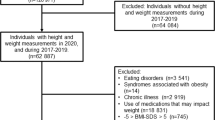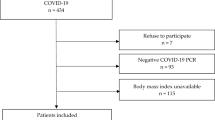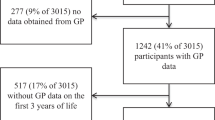Abstract
Background:
Obesity was linked to altered immunity, but also to favorable outcomes among patients with infectious disease (ID) in some settings. We assessed the association between adolescent body mass index (BMI) and ID mortality.
Methods:
BMI of 2 294 139 Israeli adolescents (60% men; age 17.4±0.3 years) was measured between 1967 and 2010. The outcome, obtained by linkage with official national records, was death due to ID as the underlying cause. Multivariable Cox proportional hazards models were applied.
Results:
During 42 297 007 person-years of follow-up (median 18.4 years), there were 689 deaths from ID (mean age 44.1±10.5 years). Adjusted hazard ratios (HR) were 1.039 (1.011–1.068) and 1.146 (1.099–1.194) among men and women, respectively, per unit increment in BMI (P for sex interaction=4.4 × 10−5). Adjusted hazard ratios among men were 1.2 (1.0–1.5), 1.9 (1.4–2.5) and 2.5 (1.5–4.2) for those with high-normal BMI (22.0–24.9 kg m−2), overweight and obese, respectively, compared with the 18.5⩽BMI<22 kg m−2 reference group, and 1.7 (1.1–2.6), 2.6 (1.6–4.3) and 6.6 (3.3–13.1) among women, respectively. The increased risk among underweight (<18.5 kg m−2) boys was attenuated when the study sample was restricted to those with unimpaired health at baseline. A multivariable spline model indicated a minimum risk for total ID mortality at 20.7 and 18.0 kg m−2 for men and women, respectively, with significantly increased risk seen above adolescent BMI values of 23.6 and 24.0 kg m−2, respectively. The association with BMI was particularly evident for bacterial infections (predominantly sepsis), airways and central nervous system infections (63% of the ID deaths).
Conclusions:
Adolescent overweight and obesity were strongly associated with ID mortality, especially of bacterial origin and among women.
This is a preview of subscription content, access via your institution
Access options
Subscribe to this journal
Receive 12 print issues and online access
$259.00 per year
only $21.58 per issue
Buy this article
- Purchase on Springer Link
- Instant access to full article PDF
Prices may be subject to local taxes which are calculated during checkout


Similar content being viewed by others
References
Ogden CL, Carroll MD, Kit BK, Flegal KM . Prevalence of childhood and adult obesity in the United States, 2011-2012. JAMA 2014; 311: 806–814.
Kontis V, Mathers CD, Rehm J, Stevens GA, Shield KD, Bonita R et al. Contribution of six risk factors to achieving the 25x25 non-communicable disease mortality reduction target: a modelling study. Lancet 2014; 384: 427–437.
Franks PW, Hanson RL, Knowler WC, Sievers ML, Bennett PH, Looker HC . Childhood obesity, other cardiovascular risk factors, and premature death. N Engl J Med 2010; 362: 485–493.
Juonala M, Magnussen CG, Berenson GS, Venn A, Burns TL, Sabin MA et al. Childhood adiposity, adult adiposity, and cardiovascular risk factors. N Engl J Med 2011; 365: 1876–1885.
Lozano R, Naghavi M, Foreman K, Lim S, Shibuya K, Aboyans V et al. Global and regional mortality from 235 causes of death for 20 age groups in 1990 and 2010: a systematic analysis for the Global Burden of Disease Study 2010. Lancet 2012; 380: 2095–2128.
Painter SD, Ovsyannikova IG, Poland GA . The weight of obesity on the human immune response to vaccination. Vaccine 2015; 33: 4422–4429.
Falagas ME, Kompoti M . Obesity and infection. Lancet Infect Dis 2006; 6: 438–446.
Kwong JC, Campitelli MA, Rosella LC . Obesity and respiratory hospitalizations during influenza seasons in Ontario, Canada: a cohort study. Clin Infect Dis 2011; 53: 413–421.
Langley G, Hao Y, Pondo T, Miller L, Petit S, Thomas A et al. The impact of obesity and diabetes on the risk of disease and death due to invasive group A streptococcus infections in adults. Clin Infect Dis 2016; 62: 845–852.
Louie JK, Acosta M, Samuel MC, Schechter R, Vugia DJ, Harriman K et al. A novel risk factor for a novel virus: obesity and 2009 pandemic influenza A (H1N1). Clin Infect Dis 2011; 52: 301–312.
Corrales-Medina VF, Valayam J, Serpa JA, Rueda AM, Musher DM . The obesity paradox in community-acquired bacterial pneumonia. Int J Infect Dis 2011; 15: e54–e57.
Mullen JT, Moorman DW, Davenport DL . The obesity paradox: body mass index and outcomes in patients undergoing nonbariatric general surgery. Ann Surg 2009; 250: 166–172.
Jackson RS, Black JH 3rd, Lum YW, Schneider EB, Freischlag JA, Perler BA et al. Class I obesity is paradoxically associated with decreased risk of postoperative stroke after carotid endarterectomy. J Vasc Surg 2012; 55: 1306–1312.
Twig G, Yaniv G, Levine H, Leiba A, Goldberger N, Derazne E et al. Body-mass index in 2.3 million adolescents and cardiovascular death in adulthood. N Engl J Med 2016; 374: 2430–2440.
Twig G, Tirosh A, Leiba A, Levine H, Ben-Ami Shor D, Derazne E et al. BMI at age 17 years and diabetes mortality in midlife: a nationwide cohort of 2.3 million adolescents. Diabetes Care 2016; 39: 1996–2003.
Keinan-Boker L, Levine H, Derazne E, Molina-Hazan V, Kark JD . Measured adolescent body mass index and adult breast cancer in a cohort of 951,480 women. Breast Cancer Res Treat 2016; 158: 157–167.
Leiba M, Leiba A, Keinan-Boker L, Avigdor A, Derazne E, Levine H et al. Adolescent weight and height are predictors of specific non-Hodgkin lymphoma subtypes among a cohort of 2352988 individuals aged 16 to 19 years. Cancer 2016; 122: 1068–1077.
Israel Central Bureue of Statistics. Characterization and Classification of Local Authorities by the Socio-Economic Level of the Population Israel Central Bureau of Statistics, Jerusalem, 2006.
Twig G, Afek A, Shamiss A, Derazne E, Landau Rabbi M, Tzur D et al. Adolescence BMI and trends in adulthood mortality: a study of 2.16 million adolescents. J Clin Endocrinol Metab 2014; 99: 2095–2103.
Kuczmarski RJ, Ogden CL, Guo SS, Grummer-Strawn LM, Flegal KM, Mei Z et al. 2000 CDC Growth Charts for the United States: methods and development. Vital Health Stat 2002; 11: 1–190.
Goldstein A, Haelyon U, Krolik E, Sack J . Comparison of body weight and height of Israeli schoolchildren with the Tanner and Centers for Disease Control and Prevention growth charts. Pediatrics 2001; 108: E108.
Inaba H, Surprise HC, Pounds S, Cao X, Howard SC, Ringwald-Smith K et al. Effect of body mass index on the outcome of children with acute myeloid leukemia. Cancer 2012; 118: 5989–5996.
Hogstrom G, Nordstrom A, Nordstrom P . Aerobic fitness in late adolescence and the risk of early death: a prospective cohort study of 1.3 million Swedish men. Int J Epidemiol 2016; 45: 1159–1168.
Goldberger N, Aburbeh M, Haklai Z Leading causes of death in Israel, 2001-2014. In: Health-Information-Division, (ed.)2nd edn. Israel Ministry of Health: Jerusalem, Israel, 2016.
Wang HE, Griffin R, Judd S, Shapiro NI, Safford MM . Obesity and risk of sepsis: a population-based cohort study. Obesity 2013; 21: E762–E769.
Huttunen R, Laine J, Lumio J, Vuento R, Syrjanen J . Obesity and smoking are factors associated with poor prognosis in patients with bacteraemia. BMC Infect Dis 2007; 7: 13.
Bernal NP, Latenser BA, Born JM, Liao J . Trends in 393 necrotizing acute soft tissue infection patients 2000-2008. Burns 2012; 38: 252–260.
Campitelli MA, Rosella LC, Kwong JC . The association between obesity and outpatient visits for acute respiratory infections in Ontario, Canada. Int J Obes (Lond) 2014; 38: 113–119.
Jain S, Kamimoto L, Bramley AM, Schmitz AM, Benoit SR, Louie J et al. Hospitalized patients with 2009 H1N1 influenza in the United States, April-June 2009. N Engl J Med 2009; 361: 1935–1944.
Kurmann A, Vorburger SA, Candinas D, Beldi G . Operation time and body mass index are significant risk factors for surgical site infection in laparoscopic sigmoid resection: a multicenter study. Surg Endosc 2011; 25: 3531–3534.
Lyons T, Neff KJ, Benn J, Chuah LL, le Roux CW, Gilchrist M . Body mass index and diabetes status do not affect postoperative infection rates after bariatric surgery. Surg Obes Relat Dis 2014; 10: 291–297.
Martin SI, Wellington L, Stevenson KB, Mangino JE, Sai-Sudhakar CB, Firstenberg MS et al. Effect of body mass index and device type on infection in left ventricular assist device support beyond 30 days. Interact Cardiovasc Thorac Surg 2010; 11: 20–23.
Stewart L, Griffiss JM, Jarvis GA, Way LW . The association between body mass index and severe biliary infections: a multivariate analysis. Am J Surg 2012; 204: 574–579.
Young KM, Gray CM, Bekker LG . Is obesity a risk factor for vaccine non-responsiveness? PLoS One 2013; 8: e82779.
Eliakim A, Schwindt C, Zaldivar F, Casali P, Cooper DM . Reduced tetanus antibody titers in overweight children. Autoimmunity 2006; 39: 137–141.
Sheridan PA, Paich HA, Handy J, Karlsson EA, Hudgens MG, Sammon AB et al. Obesity is associated with impaired immune response to influenza vaccination in humans. Int J Obes (Lond) 2012; 36: 1072–1077.
Ovsyannikova IG, White SJ, Larrabee BR, Grill DE, Jacobson RM, Poland GA . Leptin and leptin-related gene polymorphisms, obesity, and influenza A/H1N1 vaccine-induced immune responses in older individuals. Vaccine 2014; 32: 881–887.
Ostbye T, Taylor Jr DH, Yancy Jr WS, Krause KM . Associations between obesity and receipt of screening mammography, Papanicolaou tests, and influenza vaccination: results from the Health and Retirement Study (HRS) and the Asset and Health Dynamics Among the Oldest Old (AHEAD) study. Am J Public Health 2005; 95: 1623–1630.
Banerjea R, Findley PA, Sambamoorthi U . Disparities in preventive care by body mass index categories among women. Women Health 2008; 47: 1–17.
Harper DM, Else BM, Bartley MJ, Arey AM, Barnett AL, Rosemergey BE et al. In a safety net population HPV4 vaccine adherence worsens as BMI increases. PLoS One 2014; 9: e103172.
Choudhry MA, Bland KI, Chaudry IH . Gender and susceptibility to sepsis following trauma. Endocr Metab Immune Disord Drug Targets 2006; 6: 127–135.
Ghuman AK, Newth CJ, Khemani RG . Impact of gender on sepsis mortality and severity of illness for prepubertal and postpubertal children. J Pediatrics 2013; 163: 835–840 e1.
Weniger M, D'Haese JG, Angele MK, Chaudry IH . Potential therapeutic targets for sepsis in women. Expert Opin Ther Targets 2015; 19: 1531–1543.
Keith SW, Fontaine KR, Pajewski NM, Mehta T, Allison DB . Use of self-reported height and weight biases the body mass index-mortality association. Int J Obes (Lond) 2011; 35: 401–408.
Gray L, Lee IM, Sesso HD, Batty GD . Body weight in early and mid-adulthood in relation to subsequent coronary heart disease mortality: 80-year follow-up in the Harvard Alumni Study. Arch Intern Med 2011; 171: 1768–1770.
Jeffreys M, McCarron P, Gunnell D, McEwen J, Smith GD . Body mass index in early and mid-adulthood, and subsequent mortality: a historical cohort study. Int J Obes Relat Metab Disord 2003; 27: 1391–1397.
Tirosh A, Shai I, Afek A, Dubnov-Raz G, Ayalon N, Gordon B et al. Adolescent BMI trajectory and risk of diabetes versus coronary disease. N Engl J Med 2011; 364: 1315–1325.
Cohen-Manheim I, Doniger GM, Sinnreich R, Simon ES, Murad H, Pinchas-Mizrachi R et al. Body mass index, height and socioeconomic position in adolescence, their trajectories into adulthood, and cognitive function in midlife. J Alzheimers Dis 2017; 55: 1207–1221.
Kark JD, Laor A . Cigarette smoking and educational level among young Israelis upon release from military service in 1988—a public health challenge. Isr J Med Sci 1992; 28: 33–37.
Acknowledgements
This study was supported by a research grant from the Environment and Health Fund, Jerusalem, Israel (Award No. RGA 1002) to JDK.
Author contributions
GT, JDK: study concept and design, acquisition and interpretation of data, statistical analyses and drafting and critical revision of the manuscript; ED: Data file management and statistical analysis; HL, NG, ZH: Data acquisition and comments on the manuscript. NG, AL: Critical revision of the manuscript. GT and JDK take full responsibility for the integrity of the data and the accuracy of the data analysis.
Author information
Authors and Affiliations
Corresponding author
Ethics declarations
Competing interests
The authors declare no conflict of interest.
Additional information
Supplementary Information accompanies this paper on International Journal of Obesity website
Supplementary information
Rights and permissions
About this article
Cite this article
Twig, G., Geva, N., Levine, H. et al. Body mass index and infectious disease mortality in midlife in a cohort of 2.3 million adolescents. Int J Obes 42, 801–807 (2018). https://doi.org/10.1038/ijo.2017.263
Received:
Revised:
Accepted:
Published:
Issue Date:
DOI: https://doi.org/10.1038/ijo.2017.263
This article is cited by
-
Does weight influence the course of RSV bronchiolitis in hospitalized infants?
European Journal of Pediatrics (2024)
-
Adipocyte inflammation and pathogenesis of viral pneumonias: an overlooked contribution
Mucosal Immunology (2021)
-
Adolescent and Childhood Obesity and Excess Morbidity and Mortality in Young Adulthood—a Systematic Review
Current Obesity Reports (2021)
-
Cardiovascular morbidity, diabetes and cancer risk among children and adolescents with severe obesity
Cardiovascular Diabetology (2020)
-
Cognitive function in adolescence and the risk for premature diabetes and cardiovascular mortality in adulthood
Cardiovascular Diabetology (2018)



